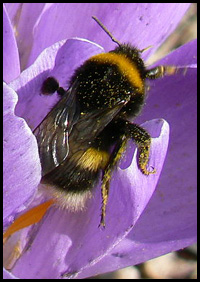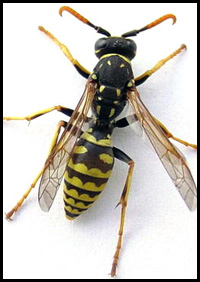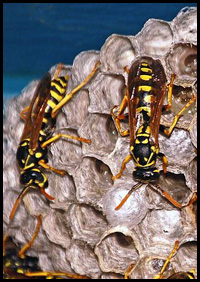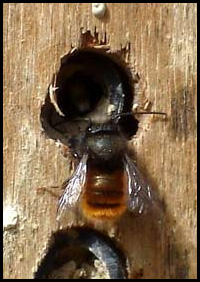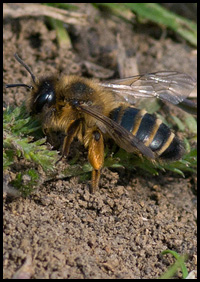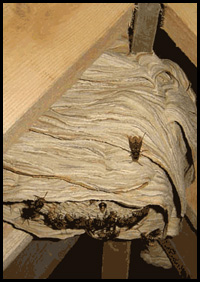What kind of insect have you found?
-
If you find a swarm of bees, the first thing to do is to make sure they’re honeybees. There are lots of different types of bee in Britain – around 250 different species – including bumblebees, the honeybee and numerous small solitary species. Add to that list Wasps and Hornets and you can see why some people become confused.
Below we have provided some information to help you find out what kind of insect you have and how to tell them apart.
Are they Bumblebees?
Bumblebees come in a range of sizes and markings, but they can usually be distinguished by their rounder, larger, hairy bodies, and a louder than normal buzz. They also come with a variety of coloured stripes across the end of their tails.
Their life cycle is annual and only the queens survive through winter to start a new colony each spring. From February onwards you will see Queen Bumblebees feeding on flowers like crocus, willow catkins, bluebells and lungwort. You might see them flying low over the ground searching for somewhere to start their nests. Whilst many prefer to nest at ground level, under stones or decking, in your compost, or underground by making use of an abandoned mouse’s nest, some can and will nest in a bird box.
Bumblebees are rarely known to sting; they never swarm like honeybees and don’t generally reach more than one hundred bees in a colony, usually much less. They are an important pollinator and many are under threat of extinction so if possible please leave them alone as the nest will die off by the Autumn whilst the new Queen will go off and hibernate until the following spring.
For more information contact the Bumblebee Conservation Trust.
Are they Wasps?
Wasps are distinctive by their very smooth appearance and by being bright yellow with black stripes. They also have a high pitched buzz. Wasps will nest in trees, under roof tiles or in sheds but unlike the honeybees’ comb, which is constructed from beeswax, the wasp’s nest is made from a very delicate paper material, made from wood scrapings and saliva.
Just like Bumblebees in the autumn all the workers and drones die, leaving only newly mated queens to hibernate and start a new colony the following spring, usually in a new location.
Wasps are attracted to anything sweet and whilst they do not usually pose a threat if left alone, they can be a nuisance in the kitchen or when eating outside. They are predators of other insects, including honeybees. If destruction is necessary, the local Pest Control Officer should be called in.
For more information about Wasps please visit BWARS - the national society dedicated to studying and recording bees, wasps & ants (aculeate Hymenoptera) in Britain & Ireland.Are they Solitary Bees?
Another group of insects that sometimes cause concern are Solitary Bees. These are harmless bees and as their name suggest live more or less alone. They come in all sizes and shapes and colours. Mated females over-winter and in the spring, excavate tunnels in the ground, or use hollow twigs or old masonry walls, depending on the species. The adult bees are visible only for 6-8 weeks during their breeding cycle which coincides with the flowering period of their preferred food source. They provision the tunnels with pellets of pollen onto which they lay an egg. When the tunnel is full the female seals it and her job is done; she never gets to see her offspring.
If your garden, house or outbuildings present the right accommodation then you may be blessed with solitary bees. They aren't interested in you and, like Bumblebees, should be left alone.
For more information take a look at this excellent website on Solitary Bees .
Are they Hornets?
The ‘hornet’ is our largest species of social wasp with queens averaging around 3cm in length. Once only common in central southern England, in the last 20 years the species has extended its range eastwards into Sussex and Kent and northwards to Yorkshire. The hornet comes with a mix of brown, red and orange-yellowish markings and has a very loud buzz.
Over-wintering queens emerge in the spring and start their nests, usually in hollow trees or similar cavities. In the autumn new queens and males emerge from the nest, mate and disperse, with the males dying and the newly-mated queens seeking over-wintering hibernation sites. Back at the nest, which may persist into November in mild years, the old queen and remaining workers eventually die-out.
Hornets are in fact relatively docile and problems only arise if nests are threatened. They help maintain balance in nature by preying upon other invertebrate species, some of which are regarded as agricultural pests.
For more information about Hornets go to BWARS.Are they Honeybees?
Honeybees are similar in size to wasps and vary in colour from golden brown to almost black. They live in large colonies, and can take up residence in hollow trees, under roofing tiles, and in unused chimneys. On a fine day you will see plenty of activity as the bees leave and return to the nest usually through a single entrance. They exist as a colony through winter as well as summer, and if left alone pose very little threat.
When in a swarming cluster, they can be removed by a beekeeper.
So if you’re sure you have a swarm of Honeybees please don’t panic. The bees are usually quite docile while they are swarming. To be on the safe side keep children and pets well away so that the bees are not disturbed, close any open windows overlooking the swarm.
If you are not in the Wantage area then call your local beekeeping association. If you don’t know how to contact your local beekeeping association then contact the British Beekeepers Association or contact your public library, your local council, or the police.
Please note that any assistance given by a beekeeper is provided on the basis that neither the Association nor its members can be held responsible for any inadvertent misadventure during the process of collecting swarms. Beekeepers are not builders, tree surgeons or steeplejacks!
Useful Sites | Links
links
-
Log In
Registered Charity No. 1015801. © 2010 Vale & Downland Beekeepers Association. All rights reserved.Copyright Notice, Disclaimer and Privacy Statement


